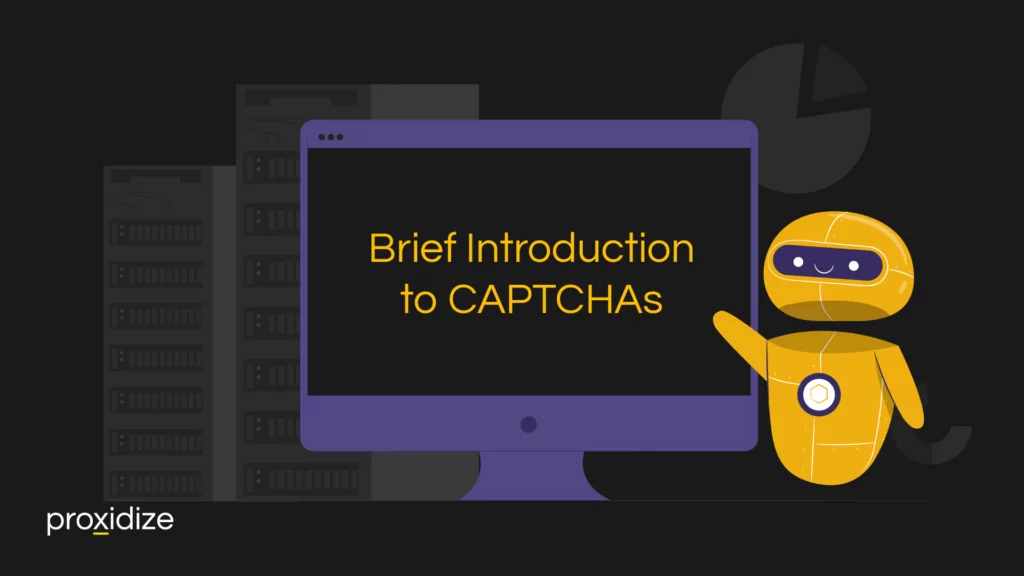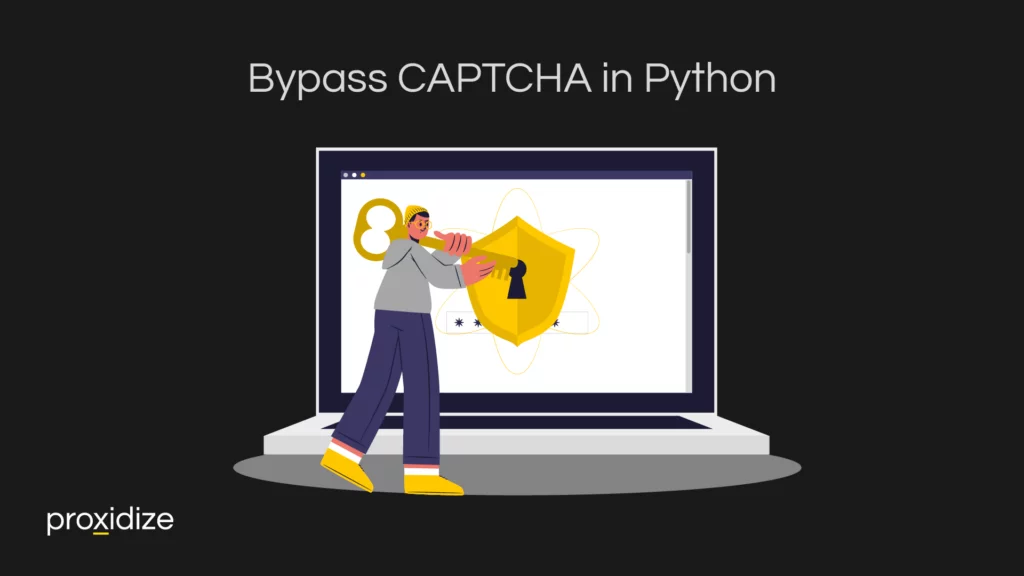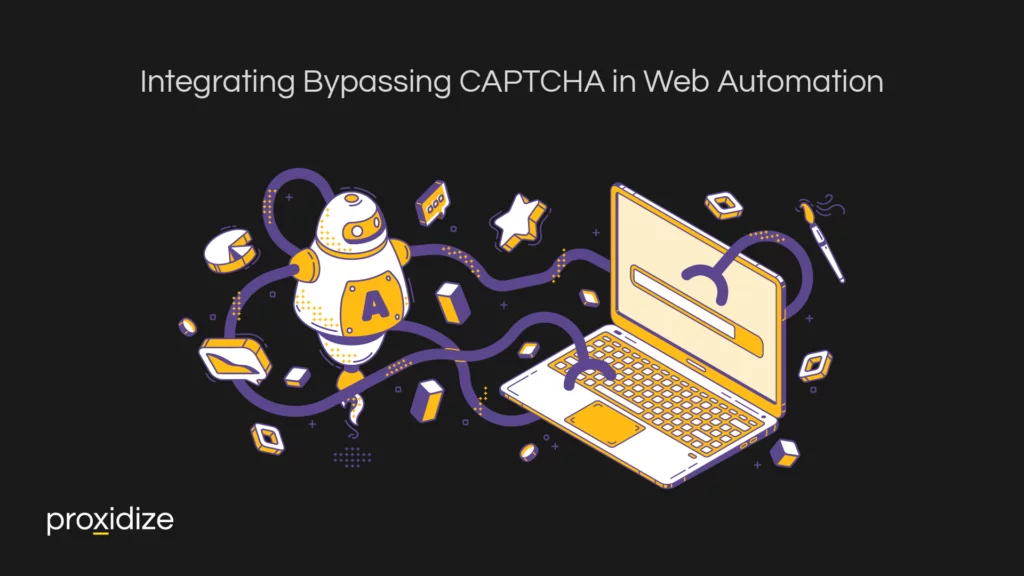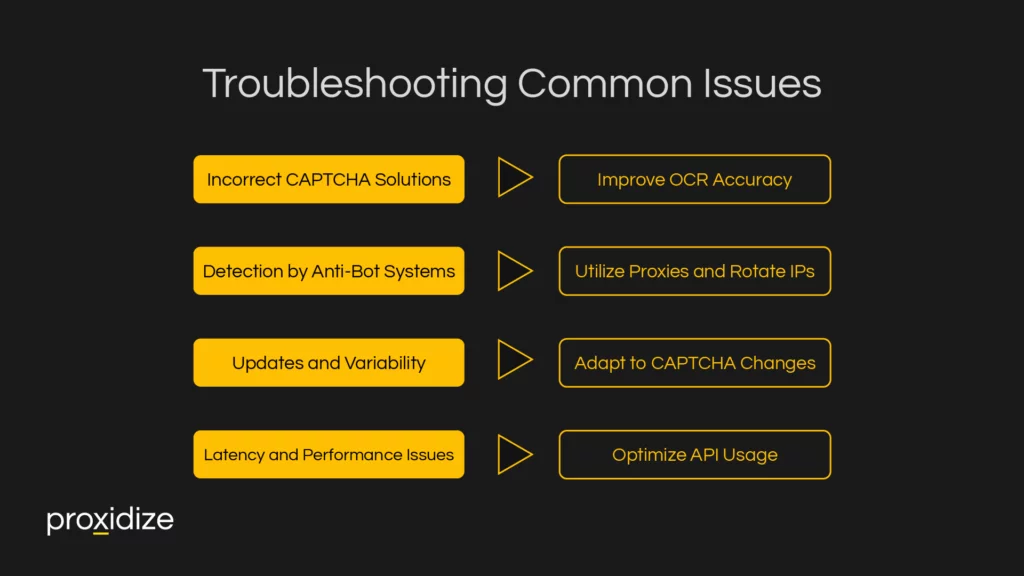An important part of automating tasks is the ability to bypass captcha. Designed to be a way to trip up or catch out bots, captcha has become efficient since its inception. Methods to overcome them, however, have also advanced. Effectively bypassing captchas ensures smoother automation processes and can significantly enhance the efficiency of web scraping, data collection, and other automated activities.
This article will explore the methods and techniques to bypass captcha using Python, providing detailed sample code to guide you through the implementation. You will find a step-by-step breakdown of writing the necessary code, including a practical example of using a captcha solver. This guide will equip you with the knowledge and tools needed to seamlessly integrate captcha bypass solutions into your automation scripts, ensuring your projects run efficiently without unnecessary interruptions.

Brief Introduction to Captchas
Captcha is an acronym for “Completely Automated Public Turing Test to Tell Computers and Humans Apart”. It is, as the name suggests, a test to tell if the user is a human or a bot. This test enhances web security by preventing automated bots and bad actors from accessing and abusing online services. The test prevents bots from creating many unwarranted accounts that could be used for anything from affecting online polls, buying multiple tickets for scalping purposes, or mass buying sneakers through the use of a sneaker bot.
Types of Captchas
There are many captcha types, each being created to evolve the practice and make it more difficult for bots to bypass. The oldest and most traditional form of captcha is the text-based test which presents users with a visually altered collection of numbers and letters that the users must decipher. The next form of test is the image-based captchas that show users a collection of images and asks them to choose the ones that correlate to the prompt (all buses, bikes, or streetlights).
High-quality scraping and automation starts with high-quality mobile proxies
Audio captchas were developed to assist the visually impaired as a way to speak the letters or numbers for the user to type in. This audio is often placed with background noise that makes it difficult for automated systems to solve. Finally, math-based captchas present an easy equation of the text-based, having the user solve a simple mathematical equation to proceed. There are many other variants of the aforementioned tests such as the slide-tile test and a 3D image pointing test but at their base, those are the most common forms of tests.
Techniques for Bypassing Captchas
Despite the work being put towards captcha tests and preventing bots, there are some methods put in place to bypass captcha. The need to bypass the tests could be for simple web scraping practices for market research or competitive analysis, saving time and effort in gathering publicly available information.
Overview of Bypass Methods
- Optical Character Recognition (OCR): Uses software to recognize and interpret text-based captchas. Advanced OCR tools can decode distorted and obscured text.
- Machine Learning and AI: Trains algorithms on large datasets to recognize and solve captcha patterns, simulating human behavior to bypass captcha challenges that analyze user interactions.
- Captcha-Solving Services: Employs human workers to solve captchas. Users submit captcha images to the service, and human operators provide solutions.
- Browser Automation Tools: Utilizes tools like Selenium to automate web interactions. Combined with OCR or captcha-solving services, these tools can bypass captchas.
- Third-Party APIs: APIs like 2Captcha and CapSolver offer programmatic captcha solutions, integrating human solvers into automated workflows. Many of these also services also offer browser extension tools.
Pros and Cons
Pros:
- Efficiency: Automating captcha bypass speeds up tasks like web scraping and automation.
- Scalability: Machine learning and third-party services can handle large volumes of captcha challenges efficiently.
- Cost-Effectiveness: Automated solutions can be more cost-effective than manual captcha solving.
Cons:
- Ethical and Legal Issues: Bypassing captchas can violate website terms of service and may be illegal.
- Detection and Countermeasures: Websites continuously improve their captcha systems to detect and block automated solvers.
- Reliability: Automated methods can vary in success rate; human-based services are more reliable but slower and potentially more expensive.

Bypass Captcha with Python
With the basics of captcha out of the way, let us explore how exactly you could bypass captcha with Python in practice. This section will introduce how to set up your environment and a step-by-step implementation. For this article, we will be exploring how to implement CapSolver as the bypass tool.
First off, you would need to set up your environment. It is recommended to install three Python libraries, those being Selenium, Requests, and PyTesseract. Selenium will allow you to interact with web pages and is used to navigate the captcha page and perform actions like clicking buttons or entering text. This practice could be made more efficient with the use of a headless browser through an anti-detect browser. Requests are used to make HTTP requests which is useful for interaction with web APIs. PyTesseract is useful if you are dealing with text-based tests as the OCR tool can help extract text from images.
You can install these libraries using pip:
pip install selenium requestsNext, you would need to install a web driver as Selenium requires one to interact with a web browser. You must make sure that the driver you install is applicable to the browser you are using.
If you are dealing with text-based tests, you would need to install Tesseract. Tesseract is an OCR engine. You need to download and install it separately, then add its executable to your system’s PATH.
Finally, you would need to install the captcha solver service of your choice. As previously stated, we will be exploring CapSolver for this example. In this instance, you would need an API key from CapSolver to use their service.
Example Code: Using CapSolver to Bypass Captcha
- Set up Selenium and navigate to the captcha page:
from selenium import webdriver
from selenium.webdriver.common.by import By
import requests
import time
# Set up the web driver
driver = webdriver.Chrome(executable_path='path_to_chromedriver')
# Navigate to the CAPTCHA page
driver.get('URL_of_the_CAPTCHA_page')
time.sleep(2) # Allow time for the page to loadUse CapSolver API to solve reCAPTCHA:
# Your CapSolver API key
api_key = 'YOUR_CAPSOLVER_API_KEY'
# Site key for the reCAPTCHA
site_key = 'SITE_KEY'
# URL of the page with the reCAPTCHA
url = 'URL_of_the_page'
# Request payload
payload = {
'clientKey': api_key,
'task': {
'type': 'NoCaptchaTaskProxyless',
'websiteURL': url,
'websiteKey': site_key
}
}
# Send request to CapSolver
response = requests.post('https://api.capsolver.com/createTask', json=payload)
task_id = response.json().get('taskId')
# Check task status
while True:
result = requests.post('https://api.capsolver.com/getTaskResult', json={'clientKey': api_key, 'taskId': task_id}).json()
if result.get('status') == 'ready':
recaptcha_response = result.get('solution').get('gRecaptchaResponse')
break
time.sleep(5) # Wait before checking againEnter the captcha solution and submit the form:
# Execute JavaScript to set the reCAPTCHA response
driver.execute_script(f'document.getElementById("g-recaptcha-response").innerHTML = "{recaptcha_response}";')
# Submit the form
submit_button = driver.find_element(By.ID, 'submit_button_id')
submit_button.click()If you put that all together, you should have the necessary code to bypass captcha. However, when implementing the code, make sure to replace values such as those below with the actual values you use:
- Path_to_chromedriver
- YOUR_CAPSOLVER_API_KEY
- SITE_KEY
- URL_of_the_CAPTCHA_page

Integrating Bypassing Captcha in Web Automation
Designing a robust workflow for captcha bypass in web automation involves several key steps:
- Initial Setup and Navigation: Use an automation tool like Selenium to navigate to the target webpage and prepare for captcha interaction. This includes setting up the web driver, loading the page, and locating the captcha element.
- Detection and Handling: Implement logic to detect the presence of a captcha on the page. Once detected, the workflow should determine the type of captcha and select the appropriate bypass method. For example:
- For text-based captchas, capture the captcha image and process it with OCR.
- For image-based captchas, use machine learning models to recognize the required objects.
- For reCAPTCHA, use a third-party solving service to obtain the solution token.
- Integrating with Automation Tools: After solving the captcha, integrate the solution back into the automation workflow. This involves using Selenium to input the solved captcha text or token into the appropriate fields and proceed with the desired actions on the webpage, such as form submission or navigation.
- Error Handling and Retrying: Implement robust error handling to manage failed captcha bypass attempts. This can include retrying the captcha solution, logging errors for further analysis, and adjusting the bypass strategy as needed.
- Maintaining Anonymity and Security: Use techniques to avoid detection by anti-bot systems. This includes rotating mobile proxies, simulating human-like interactions (randomizing mouse movements, page delays, etc.), and frequently updating the bypass methods to adapt to changes in captcha systems.
By combining these techniques and designing a well-structured workflow, you can effectively integrate captcha bypass into web automation processes, enhancing the efficiency and success rate of your automated tasks.

Troubleshooting Common Issues
Common Problems
- Incorrect Captcha Solutions: Sometimes, the automated or human-provided solutions for captchas are incorrect, leading to repeated failures and blocking of requests.
- Detection by Anti-Bot Systems: Websites often have sophisticated anti-bot mechanisms that can detect automated captcha solvers, resulting in blocked or blacklisted IP addresses.
- Updates and Variability: Captchas frequently update their patterns and complexities, which can render previously effective bypass methods obsolete.
- Latency and Performance Issues: Solving captchas, especially through third-party services, can introduce significant delays in the workflow and affect overall performance.
Solutions and Workarounds
- Improve OCR Accuracy: Enhance OCR accuracy by pre-processing captcha images. Use advanced OCR tools or machine learning models tailored to the specific type of captcha.
- Utilize Proxies and Rotate IPs: To avoid detection, use a pool of rotating proxies to distribute requests across multiple IP addresses, reducing the risk of being flagged by anti-bot systems.
- Adapt to Captcha Changes: Continuously monitor and analyze captcha updates. Adapt your bypass methods by retraining machine learning models or updating scripts to handle new captcha formats.
- Optimize API Usage: When using third-party captcha-solving services, optimize API calls by batching requests or using asynchronous programming to minimize latency. Ensure you choose a reliable service with a high success rate and low response time.
Optimization Tips
- Pre-Processing Techniques: Apply image pre-processing techniques such as binarization, erosion, and dilation to improve the quality of input for OCR tools. This can significantly increase the success rate of text-based captcha solutions.
- Error Handling and Retries: Implement robust error handling mechanisms to catch and log failures. Use exponential backoff strategies for retries to avoid rapidly repeated failures and reduce the risk of being detected.
- Performance Monitoring: Regularly monitor the performance of your captcha bypass workflow. Track metrics such as success rate, response time, and error rate to identify bottlenecks and areas for improvement.
- Leverage Machine Learning: For image-based captchas, consider using deep learning models trained on a large dataset of captcha images. This can improve accuracy and adaptability to new captcha types.
By understanding these common problems and implementing effective solutions and optimizations, you can enhance the reliability and efficiency of your captcha bypass workflows.
Conclusion
Using Python to bypass captcha can significantly streamline web automation tasks, but it requires a careful blend of techniques and tools. By leveraging OCR, machine learning, and services like CapSolver, you can effectively overcome captcha challenges. When incorporating code into Python to bypass captcha, consider the type of tests that you will come across and implement the necessary lines of code to effectively bypass them. This will result in more efficient and uninterrupted automation.
Frequently Asked Questions
How to bypass captcha?
To bypass captcha, you can use techniques like Optical Character Recognition (OCR) for text captchas, machine learning models for image-based captchas, or third-party captcha-solving services. These methods programmatically solve captchas and integrate the solutions into automated workflows.
What are some captcha solver extensions?
Some popular captcha solver extensions include Buster: Captcha Solver for Humans, AntiCaptcha by 2Captcha, and CapSolver which uses humans to solve the tests. These extensions automate the process of solving captchas within web browsers.
How to remove captcha on Chrome?
You can reduce captcha prompts on Chrome by ensuring your browser is up-to-date, clearing cookies and cache, and using reputable browser extensions like Buster. However, complete removal isn’t typically possible as captchas are enforced by websites for security purposes.
Would using a free captcha bypass work?
Using free captcha bypass tools can work, but they often come with limitations such as lower accuracy, slower response times, and potential security risks. Paid services generally offer more reliable and faster solutions.
How do websites detect captcha bypass attempts?
Websites use various methods to detect captcha bypass attempts, including monitoring for abnormal behavior, analyzing the patterns of requests, and implementing sophisticated anti-bot mechanisms. Frequent detection can lead to block or blacklisting of IP addresses so it is best recommended to use a proxy server that rotates your IP address and keeps you hidden.
Is it illegal to bypass captcha?
Bypassing captcha can be against the terms of service of the website you are accessing. Websites use captcha to prevent automated access, and bypassing it may violate legal regulations or the website’s policies. It’s important to understand and respect these terms and consider the ethical implications before attempting to bypass captcha systems.




